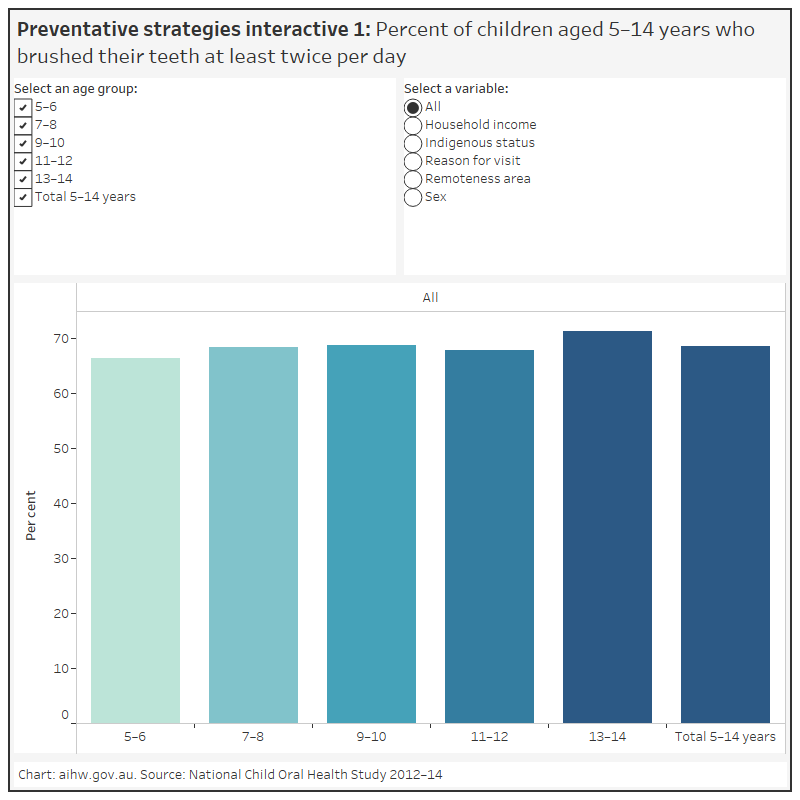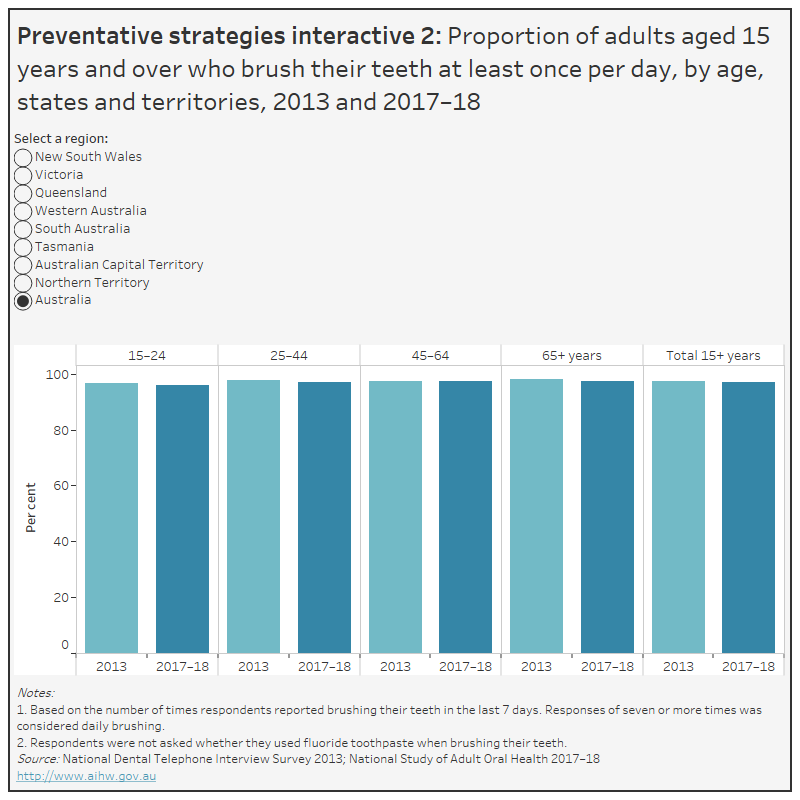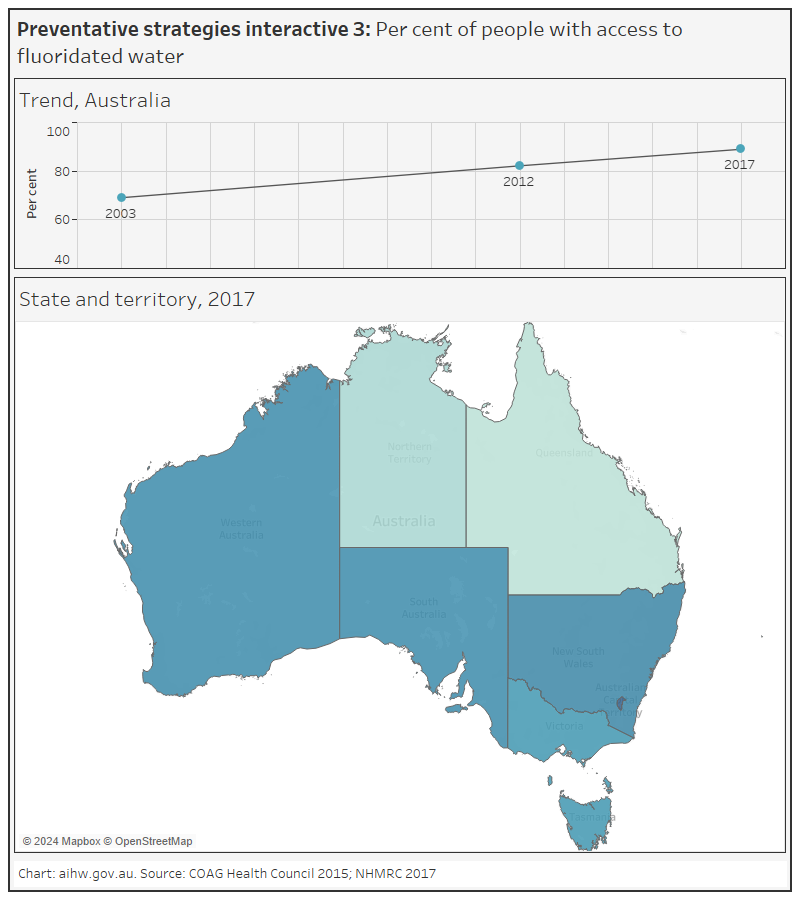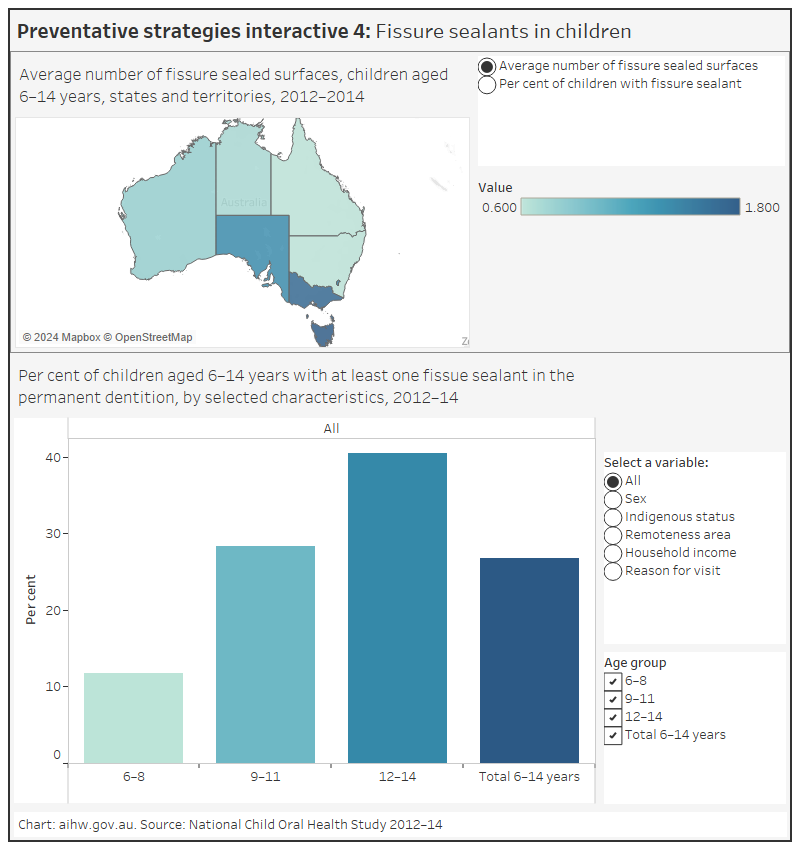Preventative strategies
The goal of Australia’s National Oral Health Plan 2015–2024 (COAG Health Council 2015) is to improve the oral health status and reduce the burden of poor oral health across the Australian population. The Plan outlines national strategic directions at both the population and individual level, across six Foundation Areas, the first being oral health promotion. Key strategies of this Foundation Area include:
- extending access to the preventive effects of fluoride
- broadening the availability of evidence-based oral health promotion programs
- strengthening and embedding nutrition and oral health policies in key settings, for example early childhood education.
Key terms
- Fluoride: A naturally occurring trace mineral that helps to prevent tooth decay.
- Water fluoridation: The process of adjusting the amount of fluoride in drinking water.
- Fissure sealants: Materials applied to the pits and fissure surfaces of teeth to create a thin barrier, which protect the sealed surfaces from caries.
Toothbrushing
Brushing your teeth twice per day with a fluoridated toothpaste can be effective in preventing tooth decay. Tooth brushing with a fluoridated toothpaste mechanically removes and controls the build-up of plaque, and applies fluoride to the teeth.
Children
The data presented in this section were sourced from the National Child Oral Health Study 2012–14 (Do & Spencer 2016).
Around two-thirds of children (69%) aged 5–14 years brushed their teeth at least twice a day with toothpaste
- Girls (71%) were more likely to have brushed their teeth at least twice a day with toothpaste than boys (66%).
- Indigenous children (54%) were less likely to brush their teeth twice a day with toothpaste than non-Indigenous children (70%).
- Children who last visited the dentist for a dental problem (65%) were less likely to brush their teeth twice a day with toothpaste than those who last visited for a check-up (73%).
- Children from high-income households (78%) were more likely to brush their teeth than children from low-income households (59%).
Preventative strategies – Interactive 1
This figure shows the percent of children aged 5–14 years who brushed their teeth at least twice per day, by selected characteristics. National data is presented for 2012–14. In Australia, 68.5% of children aged 5-14 years brushed their teeth at least twice per day in 2012–14.

See Data tables: Preventative strategies for data tables.
Adults
The data presented in this section were sourced from the National Study of Adult Oral Health 2017–18 (ARCPOH unpublished).
In 2017–18, almost all (97%) adults aged 15 years and over brushed their teeth at least once per day
- Fewer adults aged 15 years and over brushed their teeth at least once per day in South Australia (95%) than any other state or territory.
Preventative strategies – Interactive 2
This figure shows the proportion of adults aged 15 years and over who brush their teeth at least once per day, by age group. National, state and territory data is presented for 2013 and 2017–18. In Australia, 97% of adults aged 15 years and over brushed their teeth at least once per day in 2017–18.

See Data tables: Preventative strategies for data tables.
Water fluoridation
Community water fluoridation is a safe strategy to improve oral health by reducing the risk of dental caries. The Australian Government National Health and Medical Research Council found that water fluoridation reduces tooth decay by 26% to 44% in children and adolescents, and by 27% in adults (NHMRC 2017).
Around 89% of the Australian population have access to fluoridated drinking water
- The proportion of the Australian population with access to fluoridated drinking water has increased over time from 69% in 2003, to 89% in 2017.
- Around 76% of the Queensland population has access to fluoridated water, whereas around 100% of the Australian Capital Territory’s population has access to fluoridated water.
Preventative strategies – Interactive 3
This figure shows the per cent of people with access to fluoridated water. National, state and territory data is presented for 2003, 2012 and 2017. In Australia, 82.2% of people had access to fluoridated water in 2012 and 89.0% in 2017.

See Data tables: Preventative strategies for data tables.
Fissure sealants in children
Due to their structure, the permanent teeth at the back of the mouth (molar teeth) can be difficult to keep clean. These molar teeth have many grooves (fissures) and pits on their surfaces that are susceptible to developing caries. Fissure sealants may be applied to teeth to create a thin barrier that protects the sealed surfaces from caries (Do & Spencer 2016). The data presented in this section were sourced from the National Child Oral Health Study 2012–14 (Do & Spencer 2016).
Around a quarter (27%) of children aged 6–14 years had at least one fissure sealant in their permanent teeth
- The proportion of children with at least one fissure sealant in their permanent teeth increased with age, ranging from 12% in 6–8 year olds, 28% in 9–11 year olds to 40% in 12–14 year olds.
- The proportion of children with at least one fissure sealed tooth varied across states and territories, ranging from 42% in Tasmania to 17% in New South Wales. Children in Tasmania had an average of 1.8 fissure sealed tooth surfaces per child.
Preventative strategies – Interactive 4
This figure shows the average number of fissure sealed surfaces in children aged 6–14 years. State and territory data is presented for in 2012–2014. This figure also shows the per cent of children aged 6–14 years with at least one fissure sealant in the permanent dentition, by selected characteristics. National data is presented for 2012–14. In Australia, 26.8% of children aged 6-14 years had at least one fissure sealant in the permanent dentition in 2012–14.

See Data tables: Preventative strategies for data tables.
References
COAG (Council of Australian Governments) Health Council 2015. Healthy Mouths, Healthy Lives: Australia’s National Oral Health Plan 2015–2024. Adelaide: South Australian Dental Service.
Do LG & Spencer AJ (editors) 2016. Oral health of Australian children: the National Child Oral Health Study 2012–14. Adelaide: University of Adelaide Press.
NHMRC (National Health and Medical Research Council) 2017. NHMRC Public Statement 2017 - Water Fluoridation and Human Health in Australia. Canberra: NHMRC. https://nhmrc.gov.au/sites/default/files/documents/reports/fluoridation-public-statement.pdf


